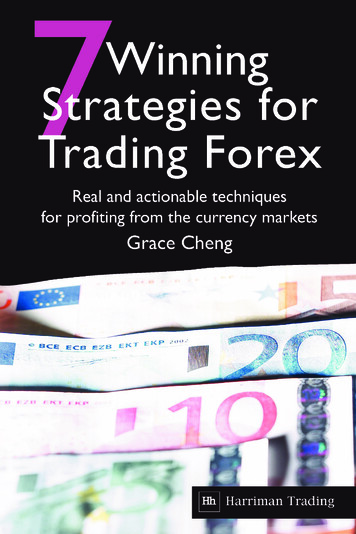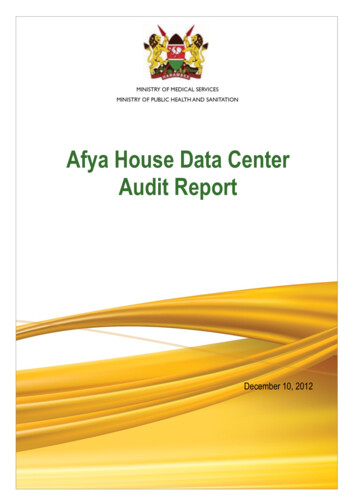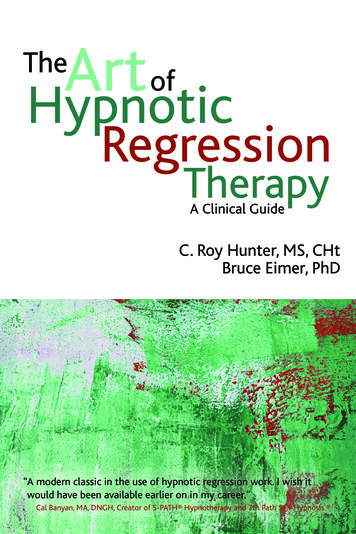
Transcription
XXX XXX1
Sample
The Law of VibrationThe Revelation ofWilliam D. GannTony Plummer
HARRIMAN HOUSE LTD3A Penns RoadPetersfieldHampshireGU32 2EWGREAT BRITAINTel: 44 (0)1730 233870Email: enquiries@harriman-house.comWebsite: www.harriman-house.comFirst edition published in Great Britain in 2013Copyright Tony PlummerThe right of Tony Plummer to be identified as the author has been asserted in accordance with theCopyright, Design and Patents Act 1988.978-0-85719-259-2British Library Cataloguing in Publication DataA CIP catalogue record for this book can be obtained from the British Library.All rights reserved; no part of this publication may be reproduced, stored in a retrieval system, ortransmitted in any form or by any means, electronic, mechanical, photocopying, recording, orotherwise without the prior written permission of the Publisher. This book may not be lent, resold,hired out or otherwise disposed of by way of trade in any form of binding or cover other than thatin which it is published without the prior written consent of the Publisher.Printed in the UK by Lightning Source.No responsibility for loss occasioned to any person or corporate body acting or refraining to act asa result of reading material in this book can be accepted by the Publisher, by the Author, or by theemployer of the Author.HhHarriman House
For the global community ofindependently-minded technicalanalysts and economists
ContentsAbout the iChapter 1: The Enigma of William D. Gann1Chapter 2: The Golden Ratio and the Christian Scriptures11Chapter 3: The Law of Three19Chapter 4: The Sign of the Prophet Jonas25Chapter 5: The Son of Man in the Heart of the Earth41Chapter 6: The Structure of the Musical Octave53Chapter 7: The Law of Seven59Chapter 8: The Octave and the Enneagram67Chapter 9: The Enneagram and Financial Markets81Chapter 10: William D. Gann and the Law of Vibration93Chapter 11: George I. Gurdjieff and the Law of Vibration103Chapter 12: St. Matthew’s Gospel and the Law of Vibration115Chapter 13: A Universal Pattern of Vibration127Chapter 14: Inner Octave Cycles147Chapter 15: The Law of Vibration in Practice159Chapter 16: The Final Word175AppendicesAppendix 1: Numerical Equivalents of New Testament Greek Letters179v
TONY PLUMMERT H E L AW O F V I B R AT I O NAppendix 2: St. Matthew’s Gospel, Chapter 12, Verses 38-40, Greek Text 181Appendix 3: The Vesica Piscis and Time183Appendix 4: The Structure of William Gann’s Tunnel Thru the Air185Appendix 5: The Structure of George Gurdjieff ’s Beelzebub’s Tales187Appendix 6: The Structure of the First 28 Chapters of Beelzebub’s Tales189Appendix 7: The 1940-45/46 Inter-Cycle Hiatus193Appendix 8: A Note on William Gann’s The Magic Word195Bibliography199Index203vi
About the authorTony Plummer is the director of Helmsman Economics Ltd. He is a formerdirector of Hambros Bank Ltd, of Hambros Fund Management PLC, and ofRhombus Research Ltd. He is a Fellow of the Society of Technical Analysts inthe UK and was, until November 2011, a Visiting Professorial Fellow in theDepartment of Economics at Queen Mary, University of London. He is theauthor of Forecasting Financial Markets, which describes the influence of crowdpsychology on economic activity and financial market price behaviour.Tony has worked and traded in financial markets since 1976, concentratingprimarily on bonds and currencies. He now specialises in long-term economicand financial market analysis, and writes and lectures on group behaviour andtrading competencies.He has a Masters degree in economics from the London School of Economics andan Honours degree in economics from the University of Kent. He has had four yearsof training in Core Process Psychotherapy and is a qualified NLP practitioner.AcknowledgementsMy thanks go very specifically to: first, my wife Glenys who has made so muchpossible; second, my former Executive Director and mentor at Hambros BankLtd, David Tapper, without whom my deep interest in financial markets wouldnever have been catalysed; and, third, my clients at Helmsman Economics Ltd,whose desire to stay one step ahead of the consensus has persistently energisedmy research into the patterns of collective human behaviour.vii
PrefaceI have for many years been fascinated by the hidden aspects of Nature: by theorder underlying the apparent chaos; by the limited set of mathematical ratiosthat appear to reflect that order; and by our personal involvement in that order.It is my strong belief that individual decisions are almost always contaminatedby collective beliefs and shared moods, and that therefore we have far less controlover our affairs than is supposed. The result, however, is a form of systemiccoherence that is not yet accepted by conventional economic theory.This book is about a critical aspect of this systemic coherence. It is about a verydistinctive pattern that emerges in the presence of natural cyclical behaviour.Astonishingly, the pattern was hidden almost 2000 years ago in a small piece oftext in the Greek version of the Christian Gospel of St. Matthew. The patternwas unearthed, and then buried again, by the famous financial market speculatorWilliam D. Gann. And the same pattern was alluded to, but also hidden, bythe great mindfulness exponent George I. Gurdjieff. The lineage of the cyclepattern suggests that it represents a genuine revelation. It has taken me morethan 20 years to unravel the code that has hidden this revelation, and I feel veryprivileged to have been able to do it.This book, then, is about a law of vibration that is alleged to permeate thecosmos. There is strong evidence that this law influences financial marketfluctuations and economic cycles. But the exciting possibility is that signs of thelaw of vibration can be found in a whole range of research disciplines – fromcosmology at one end to quantum physics at the other. It may be that WilliamGann was an important link in a chain of transmission that – at a minimum –can be dated back almost two millennia.ix
IntroductionTHE ROLE OF SHOCKSIt is a great truth that real change only ever comes out of crisis. This is the wayof evolution, which impacts all living organisms, at all levels of being andunderstanding. A new item of information – a shock – sends fluctuations deepinto a system and the subsequent feedback becomes increasingly destabilisinguntil the system flips into a different state. Unfortunately, the crisis is inevitablypainful for all concerned. This is the path of change that involves such diverseevents as wars, revolutions, stock market crashes, mental breakdowns andphysical diseases.In my opinion, the 2008 financial panic and subsequent recession was just sucha shock. It will undoubtedly lead to changes – both to the economy and in ourunderstandings about how it operates – for some years to come. We could justlet it all happen, and come out at the other end much older and a little wiser,but a more productive approach would be to try to understand the real causes ofthe problem and then adjust ourselves as quickly as possible. In that way, wemight be slightly less vulnerable to what Shakespeare called “outrageous fortune”.1THE CHALLENGE TO ECONOMIC THEORYAs a start, it is worth considering why economic theory was not able to anticipatethe events of the last few years – that is, the explosion and collapse in variousasset prices, and the associated economic boom and bust. A large part of theanswer can be found in three areas of debate:1. The supposedly simplifying assumptions that are used in theoreticalanalysis;2. The re-balancing mechanisms that are thought to operate in an economy;and3. The effectiveness or otherwise of government in influencing thosemechanisms.1William Shakespeare, Hamlet, Act 3, Scene 1.xi
TONY PLUMMERT H E L AW O F V I B R AT I O NWhen we make decisions, we have to take account of the fact that the futuremay not turn out as we expect. The starting point for economics, therefore, isto consider exactly how uncertain that future is. The so-called Keynesian (i.e.fiscalist, and usually socialist) view is that the future is so uncertain – and peopleso naturally cautious – that the economy will not spontaneously gravitatetowards full employment equilibrium.2 In addition, it is believed that theeconomy is likely to over-respond to negative exogenous shocks.The neo-classical (i.e. monetarist, and usually conservative) view is that risk canbe quantified in terms of probabilities and therefore priced by the relevantmarket.3 Providing that markets are efficient, information is perfect andparticipants adhere to rational expectations, the economy will therefore bedrawn towards its natural rate of unemployment. Quite obviously, a believer inKeynesian subjective uncertainty will conclude that government intervention isessential, while a believer in neo-classical objective risk will want governmentintrusion to be minimal.SIMPLIFYING ASSUMPTIONSSo who’s right? Unfortunately, as the situation stands, the answer is neither. Andit is not just a question of whether the cynical Keynesian assumption aboutpeople’s ability to deal with the future is more sensible than the unrealistic andunattainable neo-classical one. The fundamental flaw in both arguments is thepresumption that people normally make their decisions independently of oneanother. They do not. Neuroscience confirms that we are Janus-faced: we areself-assertive, but we also integrate into larger wholes.4First, we depend on the observed behaviour of others to provide informationthat we cannot access directly ourselves.5 This modulates, and then offsets, thesubjective uncertainty of Keynesian economics. Second, we absorb, and arestimulated by, the beliefs and emotions generated by others. This neutralises,and then destabilises, the objective risk presumed by neo-classical economists.Dependence on others’ behaviour still allows rational individual decisions, but2Robert Skidelsky, ‘The Relevance of Keynes’, Cambridge Journal of Economics (January 2011) and John M. Keynes,‘The General Theory of Employment’, Quarterly Journal of Economics (February 1937).3John F. Muth, ‘Rational Expectations and the Theory of Price Movements’, Econometrica (July 1961) and RobertLucas, Models of Business Cycles (Basil Blackwell, Oxford, 1987).4See, for example, Alexander Easton (Ed.) and Nathan Emery (Ed.), The Cognitive Neuroscience of Social Behaviour(Psychology Press, London, 2005).5The idea of information cascading through a crowd, as a result of individuals responding to local perturbations inconditions, has become well established in Behavioural Finance. The missing element, however, is a clear recognition(and acceptance) that human beings are programmed – like animals in herds – to take note of the behaviour of others.No individual has all the information necessary for his/her survival. Research by John Dyer has found that it takesonly 5% of people to have a decisive influence on the direction that a crowd of people would take; the rest simplyfollow. See John Dyer, et al, ‘Consensus decision making in human crowds’, Animal Behaviour 75:2 (February 2008).xii
INTRODUCTIONthe absorption of others’ beliefs and moods means that these decisions arenevertheless formed within a non-rational environment.It follows from this that government spending can be a powerful influence onindividual decisions and on collective beliefs. However, this is not the same assaying that government is truly an independent agency – let alone a gifted one.The weakness in interventionist policies is that policy-makers themselves areaffected by the general mood. This has been all too apparent in recent yearswhere politicians have tried to buy votes by increasing spending during boomconditions because it can be afforded, only to find themselves having to raise taxesduring difficult times to share the burden. The point is that, unless governmentintervention is genuinely contra-cyclical, the feedback between governmentactivity and collective psychology can be profoundly de-stabilising. Governmentactivity is a source of potential risk within the economic system.ENERGY GAPS AND REBALANCING MECHANISMSThe 2008 financial implosion and the associated economic recession arose fromthe correlated decisions of people whose mood was influenced by rapidly-risinggovernment spending and lax credit policies. It was a reaction to excesses andwas not caused by a random, externally-generated, shock. The downswing was,in fact, an energy gap within the economic system and, as such, it reversed thatsystem’s polarity from growth to contraction.I have dealt with this phenomenon in detail elsewhere,6 but the purpose of sucha gap is to initiate a process that will cleanse the system of excesses. Once theprocess starts, it will continue until it is naturally complete. Of course, sinceeconomic theory does not properly recognise the influence of collectivebehaviour, nor recognise the adjustment mechanisms created by system excesses,it cannot define the originating causes or suggest the appropriate solutions (if,indeed, there are any). And, since economic policy decisions are dependent oneconomic theory, the political result is disbelief, confusion and helplessness.This sorry state of affairs exists despite the vast sums of private and public moneythat are devoted to research and teaching in the field of economics. New ideasobviously need to be recognised and adopted so that our understanding of realitycan evolve. In my opinion, one essential change will be to include the concept ofcollective behaviour, not just as an occasional blemish on the otherwise smoothfunctioning of a rational system, but as a constant influence. And, fortunately,there are signs that the process of reconsideration and revision has started.76Tony Plummer, Forecasting Financial Markets (6th Ed.) (Kogan Page, London, 2010).See, for example, George A. Akerlof and Robert J. Shiller, Animal Spirits: How Human Psychology Dri
Gann was an important link in a chain of transmission that – at a minimum – can be dated back almost two millennia. ix. Introduction THE ROLE OF SHOCKS It is a great truth that real change only ever comes out of crisis. This is the way of evolution, which impacts all living organisms, at all levels of being and understanding. A new item of information – a shock – sends fluctuations .











